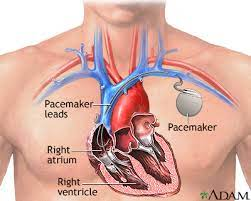Staying on Pace
- Radha Bhor

- Jul 12, 2022
- 3 min read
The pacemaker was invented in the 1950’s by a Canadian biomedical engineer named John Hopps. John Hopps was born in Winnipeg in 1919. He graduated with a degree in electrical engineering and joined the Division of Radio and Electrical Engineering by the National Research Council. He led a team whose main goal was to create devices to improve quality of life in patients affected by blindness and muscular disabilities.

During the 1940’s, Hopps also studied the use of radiofrequency reheating for
pasteurizing beer. This little experiment led to the groundbreaking invention of the cardiac pacemaker. Surgeons Wilfred Bigelow and his research fellow John Callaghan were using hypothermia to slow down the heart to perform surgery. They wanted to solve the problem of how to induce cardiac contraction during hypothermia. At the same time, Hopps was discovering how electrical impulses could cause the heart to contract at a steady rate. Hopps and his team did a series of experiments to develop the pacemaker that would stimulate the heart over a long period of time.
The first pacemaker prototype was created in 1950 and looked like a small radio. It used vacuum tubes to generate pulses, and was powered by a 60-Hz household current. Hopps also invented transvenous catheter electrodes that eliminated the need to open the chest for heart stimulation. When the implantable pacemaker was made, the original vacuum tubes were replaced by transistors to make it small enough to fit in the body. It was developed by Rune Elmqvist. In October of 1958, the pacemaker was implanted for the first time by surgeon Ake Senning. The patient was a 43 year old man with heart block and Stokes-Adams attacks. The pacemaker failed in the first three hours. Pacemakers went through a lot of development before they were able to be implanted successfully for long periods of time.
A pacemaker is a small device that is implanted in the patient’s chest to help regulate heart function. Pacemakers are often used for elderly people who have had heart problems or anyone with heart conditions. A pacemaker is normally used when a person’s heart is not beating enough or is beating too slow. A pacemaker will help ensure that heart function stays constant and at a good pace. A pacemaker could also be needed when there are problems with the heart’s electrical conduction system. There are three parts to a pacemaker: a pulse generator, one or more leads, and an electrode on each lead. The lead(s) is connected to the pulse generator on one end and the other is inside one of the heart’s chambers. The electrode touches the wall of the heart. The lead delivers electrical charges to the heart and senses the heart’s electrical activity.
This device has had a great impact on humanity because of how it has improved the quality of life for so many people. Lots of people need pacemakers to control their heart function and this allows them to increase their life expectancy. For example, there is a type of leadless pacemaker that is becoming popular. There is also the Micra Transcatheter Pacing System (TPS) with even more advanced pacing technology.
Before pacemakers were invented, many people had chronic heart problems or heart problems caused by other diseases or lifestyle choices. These people had low chances of survival due to their heart problems. The pacemaker was a groundbreaking invention that allowed people to control the pace of their heart beats. The pacemaker can be used on people of any ages that require it. This invention has saved millions of lives and new advancements in pacemaker technology are only going to improve the functionality of pacemakers and make them more globally accessible.




Comments